

Lunettes 3d passives, anaglyphes, polarisées. Comment fonctionne la 3D stéréoscopique. Stéréoscopie. Un article de Wikipédia, l'encyclopédie libre.
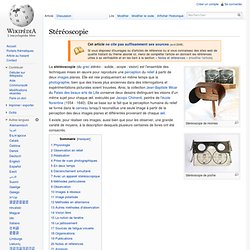
Meilleures Images en 3D sans lunettes avec la Stéréoscopie. La nouvelle tendance de 2010 c’est que tout doit être en 3D… ça tout le monde le sait, alors les cinéastes et tous les autres travaillent sur pleins de technique pour que ce soit le plus réel possible et le tout bien sur sans lunettes (des lunettes 3D bien sûr, pas n´importe quelle paires de lunettes standards)… J’ai surfé un peu sur la toile pour voir ce qu’il se faisait et je suis tombé sur la Stéréoscopie.

Définition de la Stéréoscopie (Images en 3D sans lunettes) C’est la capacité de créer avec toutes les techniques possible l’illusion de la 3D dans une image. Cela a été inventé par Sir Charles Wheatstone in 1840. Donc ça date pas d’hier… C’est d’ailleurs le même principe qui est utilisé dans les Stéréogrammes (image ou on voit rien au début puis l’image sort quand on louche)
Anaglyphe. StereoPhoto Maker (French) English , German , Japanese StereoPhoto Maker (SPM) est un éditeur d'images stéréo très souple et performant mais aussi un outil pour visionner les images stéréo.
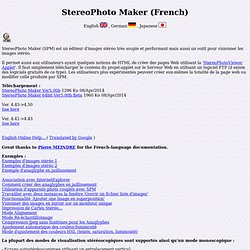
Mirascope. Mirascope. Modeling the Mirascope Using Dynamic Technology. Modeling the Mirascope Using Dynamic Technology - 1. Introduction. Author(s): Lingguo Bu (Southern Illinois University Carbondale) The mirascope is a toy made of two parabolic mirrors that fascinates children and adults alike.

The two mirrors work together and project a small object placed at the bottom to the top, creating a hologram-like illusion (Figure 1a-b). The name mirascope seems to be a blend of the two words: mirage and scope. In my college teaching experiences, I have used the mirascope to introduce ideas of geometry and its connections to algebra and physics. Modeling the Mirascope Using Dynamic Technology - 2. Preliminaries and Heuristics. To begin with, we recognize the physical foundation of the mirascope.

To see an image coming out of the mirascope, there has to be some light from the environment that reaches the object inside and is somehow bounced back to the outside. Therefore, we need to understand and model how light works and further explain how the human eye could recognize the position of a virtual image. For our purpose, there are two types of mirrors that are interesting: a plane mirror and a parabolic mirror. 2.1 The Plane Mirror. Modeling the Mirascope Using Dynamic Technology - 3. Mirascope Construction Using Geogebra. 3.1 Define Two Parabolas Algebraically In order to align the two parabolic mirrors accurately, we use algebraic functions to model the two face-to-face parabolas.

We start with two constant variables, a and c, where a controls the orientation and curvature of the parabolas, and c controls their vertical alignment or, in our case, the distance between the vertices of the two parabolas. For simplicity, we define a=0.15 through the input box and convert it to a slider with an interval of [0,2]. Also, we define c=2 through the input box and convert it to a slider with an interval of [0,5]. In GeoGebra, any free or independent variable can be converted to a slider for visualization with an initial value and an interval that defines its range of possible values. Figure 5: Construct two parabolas using an algebraic approach. Modeling the Mirascope Using Dynamic Technology - 4. Using the Simulation: Explorations and Exercises.
Once we have constructed a mathematical mirascope, we can use it to ask in-depth questions about the mirascope and the way it works.
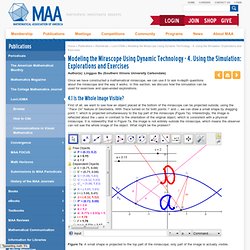
In this section, we discuss how the simulation can be used for exercises and open-ended explorations. 4.1 Is the Whole Image Visible? First of all, we want to see how an object placed at the bottom of the mirascope can be projected outside, using the “Trace On” feature of GeoGebra. With Trace turned on for both points P and J, we can draw a small shape by dragging point P, which is projected simultaneously to the top part of the mirascope (Figure 7a). Modeling the Mirascope Using Dynamic Technology - 5. Conclusion. Author(s): Lingguo Bu (Southern Illinois University Carbondale) The mirascope provides a worthwhile task to engage prospective and inservice mathematics teachers in the exploration of an appealing physical phenomenon and the development of genuine problem solving skills in STEM-oriented classes.
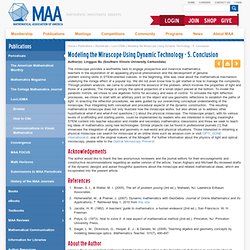
In the beginning, little was clear about the mathematical mechanism underlying the mirage effect of a popular toy. We did not even know how to get started or how to manage the complexity. Through problem analysis, we came to understand the essence of the problem, which involves the properties of light and those of a parabola. Acknowledgements. Modeling the Mirascope Using Dynamic Technology - Additional Figures. Figure 4c: Two light rays that are parallel to the -axis reach an upward parabola.
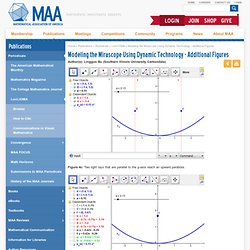
Figure 4d: Hide the intermediate steps to reduce the construction complexity. Figure 6a: A light ray from point reaches the upper parabola and is reflected to the lower one. Figure 6b: A light ray from point is reflected out of the mirascope. Figure 6d: Defining a new tool to reflect light from point out of the mirascope. In GeoGebra, click "Tools" in the menu, select "Create New Tool," and follow the onscreen directions to click the objects involved.
Holographie. Un article de Wikipédia, l'encyclopédie libre.

Hologramme. Un article de Wikipédia, l'encyclopédie libre. Deux photographies d'un même hologramme prises de points de vue différents L'hologramme est le produit de l'holographie. Il s'agit historiquement d'un procédé de photographie en relief. Aujourd'hui, un hologramme représente une image en trois dimensions apparaissant comme « suspendue en l'air ». Holhocollection, the holograms projector. Première mondiale : Des médecins israéliens utilisent des hologrammes 3D durant une opération cardiaque. Philips et RealView Imaging Ltd, une start-up israélienne spécialisée dans l’imagerie en 3D flottante, ont annoncé avoir achevé une étude clinique consistant en une opération de chirurgie mini-invasive cardiaque au cours de laquelle les médecins ont pu utiliser une image holographique en 3D du cœur en temps réel.
L’étude pilote a impliqué huit patients et a été menée en collaboration avec le Centre médical pour enfants Schneider à Petah Tikva en Israël. En plus d’afficher le cœur du patient sur un écran 2D, les médecins de l’équipe d’intervention ont pu voir des images holographiques 3D détaillées du cœur “flottant dans l’air” au cours d’une procédure de chirurgie cardiaque mini-invasive, sans l’aide de lunettes spéciales.
Les médecins ont également pu manipuler et faire ainsi tourner le cœur en 3D en touchant l’hologramme flottant face à eux. Le Dr. Cela vous intéresse ? Améliorer les soins aux patients Republier cet article Recevez nos articles par e-mail Commenter cet article.